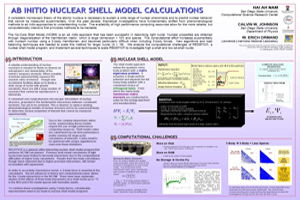 |
||||||||
 |
 |
 |
 |
 |
| Computational Challenges of AB Initio Nuclear Shell Model Calculations | ||
|
A consistent microscopic theory of the atomic
nucleus is
necessary to explain a wide range of nuclear phenomena and to
predict nuclear behavior that cannot be measured
experimentally. Over the past decade, theoretical
investigations have fundamentally shifted from
phenomenological methods to ab initio approaches to
understanding nuclei. The availability of high performance
computing resources allow for the more reliable, but
computationally intensive first principles methods to be
tractable.
The No-Core Shell Model (NCSM) is an ab initio approach that has been successful in describing light nuclei. Nuclear properties are obtained through | ||
|
diagonalization of the Hamiltonian matrix, which
is large (dimension > 10^8) and sparse. The computational effort
increases exponentially with nucleon number using a 2-body Hamiltonian,
and becomes particularly difficult when including 3-body forces,
as the matrix becomes less sparse. New algorithms and load balancing
techniques are needed to scale this method for larger nuclei (A
> 16). We analyze the computational challenges of REDSTICK, a
nuclear shell model program, and implement several techniques to
scale REDSTICK to investigate high p-shell and low sd-shell nuclei.
|
||
| • Other Abstracts • | ||
